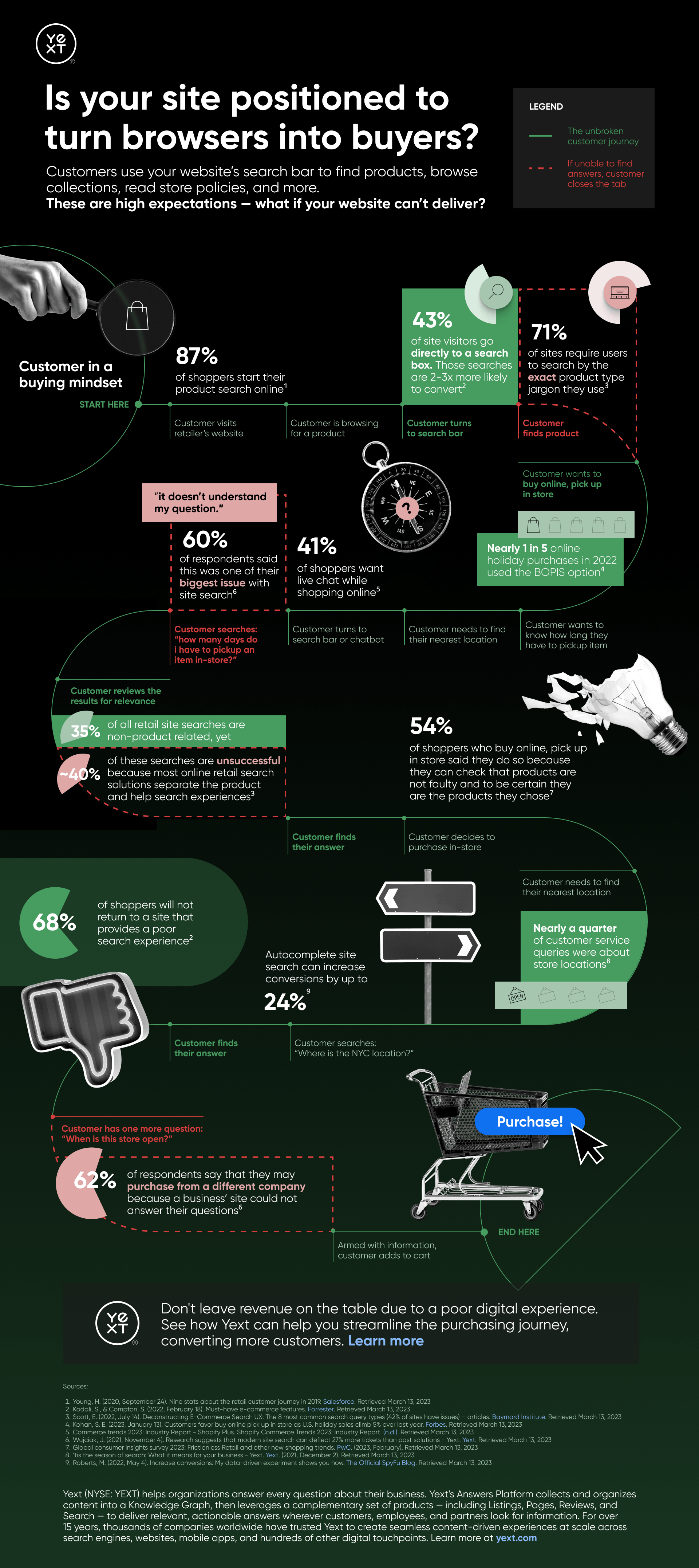Industry Insights
DTC Retail and the New Customer Journey: How Brands Can Deliver a Better Experience All Along the Purchase Funnel
Invest in building a site search experience that delivers the answers your customers seek, and turn shoppers' questions into conversions.

Derick Jaros
Feb 14, 2023

"Creating great customer experiences is integral to the success of direct-to-consumer (DTC) brands. It's in their DNA: ""Direct to consumer"" means, well, serving customers directly. It also means that DTC retailers are responsible for their customer's exposure to the brand. This is a tall order during the age of omnichannel experiences.
Today's customers drift in and out of the purchase funnel, often exiting only to re-enter via a different channel. Because of this, providing a delightful experience for each individual customer can be a difficult task. Brands are often left to guesstimate the customer's needs and expectations with little helpful information.
Converting customers and maintaining long-term relationships with them is something every brand wants. DTC brands led the charge in creating high-converting online experiences; now, consumer packaged goods (CPG) and manufacturers are again looking to DTC for clues on how to optimize the omnichannel customer journey. How can DTC retailers meet individual customers' needs despite the growing complexity of the customer journey?","### Personalization is key in the new customer journey
In the pre-internet era, the old customer journey started with a trip to the store. The new journey is much more complex. Customers weave between websites and brick-and-mortar locations. It's also common for shoppers to exit and reenter the purchasing funnel many times.
But customers still have questions throughout their omnichannel journey – often prompting the use of a search bar.
Some customers will turn to popular search engines like Google with their queries. On the Search Engine Results Page (SERP), those customers will find your competitors' advertisements, Google Business Profiles, and deals via Google Shop. But will your brand deliver the answer they searched for? If not, chances of converting that customer grow slimmer.
Other customers will turn to your site's own search engine. They'll use the search bar to discover new products, browse collections, find store policy information, and more. In this new model, consumers expect experiences that are consistent and personalized with their own journey. These are high expectations for your website's search bar.
In the new customer journey, the search experience is foundational to personalization. So how can your DTC brand craft a search experience that caters to individual humans – not vague buyer personas – while serving customers all along the marketing funnel?","### 1. Create a content-rich website, complete with personalized landing pages to capture organic search traffic.
When customers start their journey on a search engine, your brand has to show up in the results to deliver an answer.
Retail landing pages are DTC brands' greatest tool for discoverability and personalization. Landing pages meet shoppers' specific needs and moments of intent, driving traffic and conversions.
Here's an example: If your customer would ask a question like ""what is the best mattress type for side-sleepers?"" then the content on your website needs to:
- Answer this question.
- Be properly marked up so that search engines can ""read"" the page and understand it.
- Have a CTA for the customer to ""act"" on their search query. An example is a collection of merchandise that matches the description.
That's the minimum requirement for showing up in the search results. But more than just ranking in the SERP, landing pages allow retailers to meet customers wherever they are in their journey.
 ","The content of your landing pages should match specific needs and moments of intent. This ensures that it ranks organically in the search results, and naturally answers your customers' questions. A shopper browsing a category page is in a different stage of their journey than an online customer looking to make an in-store return.
","The content of your landing pages should match specific needs and moments of intent. This ensures that it ranks organically in the search results, and naturally answers your customers' questions. A shopper browsing a category page is in a different stage of their journey than an online customer looking to make an in-store return.
Brands that struggle to create landing pages should consider technology and tools that generate new, personalized resources for your customer.
2. Leverage Next-Gen AI during moments of intent – and confusion.
With the rise of ChatGPT, copy.ai and other cutting-edge resources for marketers, AI-generated content will increase across the industry. Don't limit ChatGPT's abilities to only blog writing, though. There are several use cases for Next-Gen AI throughout the customer journey.
- AI-generated Landing Page Content
Landing pages are a powerful use case for AI-generated content. Retail marketers can use this technology to craft localized copy based on product categories. It can also generate photos, FAQs, and Q&As relevant to the customer's search. The result is a personalized experience that improves the customer's impression of the brand.
A growing trend in retail is buy-online-pickup-in-store (BOPIS) and buy-online-return-in-store (BORIS). This presents a practical use case for AI-generated landing pages. Many shoppers find themselves needing both general store or product info and location-specific information, such as the address, phone number, or store hours. AI-generated local landing pages give shoppers the information they need for wherever they are in their journey.
- Conversational AI in Chat
Retailers can better engage with shoppers throughout the customer journey with conversational AI. Natural language processing and understanding enables retailers to address customer concerns immediately via chat.
In the traditional buyer journey, unanswered questions such as ""Can I buy this in a different size?"" or ""What is the return policy for this item?"" cause shoppers to exit the purchase funnel. In fact, shoppers may even turn to another channel, such as a search engine or a community site, to find the answer. When this happens, shoppers risk exposure to incorrect or outdated information.
Retailers that leverage technology to engage shoppers online, understand their product preferences, and provide real-time support will benefit from a purchasing funnel filled with delighted, educated customers.
- Accelerate Discovery + Conversions with Guided Buying Flows
Guided buying flows recreate the in-store experience for online shoppers. Guided search prompts can identify product preferences, similarly to a conversation with a store associate. Retailers can use AI to recommend items, highlight product reviews, and provide a completely personalized experience.
Remember, the goal isn't to simply drive traffic and conversions – it's to drive customer satisfaction.","### 3. Understand the ""content paradox"" and navigate it with AI-powered site search.
As we've written before, a robust website that's built to perform well across search engines will quickly become difficult for visitors to navigate. Even with a well-built navigation map, there may be too many pages to find what they're looking for.
As a result, most DTC retailers will eventually encounter the same content paradox. The more quality content, the more useful your site is to customers; and yet, the harder it is for customers to find it.
A great online experience is one where it's easy for customers to find the information they want — when they want it. Think about whether that journey is simple and intuitive when it takes place entirely on your website. Without great site search, it probably isn't.
 Download this infographic as a PDF here.","Site search converts browsers into shoppers. Let's use our example above, the query for ""what is the best mattress type for side-sleepers?"" This query demonstrates purchase intent, but how do we guide the buyer down the funnel?
Download this infographic as a PDF here.","Site search converts browsers into shoppers. Let's use our example above, the query for ""what is the best mattress type for side-sleepers?"" This query demonstrates purchase intent, but how do we guide the buyer down the funnel?
With a combination of machine learning, natural language processing, and a well-designed user interface.
Imagine the customer who types in the above query, and is met with a series of guided search prompts that re-create the in-store experience. Or, imagine the customer's delight when their search returns an entire list of products, complete with customer reviews, sorted by stars and price. You may even imagine the customer happily shopping away, not even realizing that machine learning is dynamically re-ranking the merchandise based on their engagement.
Each of these scenarios takes place every day, and customers are happier for it. In fact, Microsoft CEO Satya Nadella says AI-powered search is the biggest thing to come out in the past 15 years. ""I have not seen something like this since I would say 2007-2008, when the cloud was just first coming out,"" he told CNBC.
Invest in building a site search experience that delivers the answers your customers seek, and turn questions into conversions.","### 4. The power of first-party data: Insights straight from your customers.
To create a great on-site search experience that serves your customer, first you must understand exactly what they are asking. The questions your customers ask should play a critical role in informing the content you develop. It should also help you provide relevant answers, optimize the click path, and convert customers.
What's being typed into the search bar is more than just a query. It's pure first-party data on your consumer behaviors, buyer intent, and purchase journey. This kind of data is extremely potent as DTC retailers rely less and less on third-party cookies. If you need insights on what customers want from your brand, don't worry: they're typing it into the search bar right now.
This is invaluable information for building long-term relationships with customers. Each time they cycle through the purchase journey, they provide more insights, which DTC retailers can use to encourage future conversions. The result is a customer journey that is continuously optimized, providing a better experience each time.
Make sure to tap into your site search provider to find out what your customers are searching for, as well as when they're converting (or not). Then, use those insights to improve the customer journey – from the first question to conversion, and beyond.